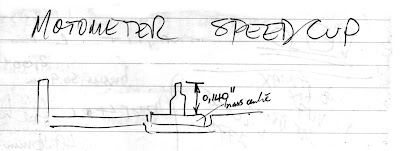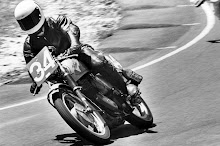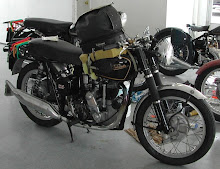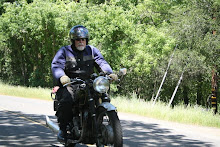This covers the instruments introduced with the BMW/6 models in late 1973 for the 1974 season.
Initially the R60/6, R75/6, R90/6 it was followed by the R60/7, R75/7 then R80/7, R100/7 and with the introduction on the monoshock rear end the R80, R100.
Left click on the images to enlarge them.
These used the "twin instruments" in a common plastic binnacle with the speedometer on the LHS and tachometer on the RHS.Initially the tachometer was a cable driven mechanical one of 2-1 ratio. The drive cable is one of the "captive" type favoured by the German speedo manufacturers where the inner cable is captive in the outer and so can't easily be removed to lubricate it. But you can do it and I will cover this in a later blog on speedometer and tachometer drive cables.
Whatever you do, DON'T oil any speedometer or tachometer inner cable..they must be greased. Oil will be transported up the spinning inner and into the mechanism of the instrument.The mechanical tacho was used from 1974-1977.
Instruments from an R90/6 with additional voltmeter and clock.
Note the colour of the dial...black with white lettering.
The plastic cover is one of three different ones used. They differed in the position of the warning lights between the speedo and the tacho.
The 1973-77 had the indicator lights at the bottom.
The 1978-81 had the brake warning light at the bottom.
The 1981 onwards had a blue light for the high beam indication at the bottom.
From 1978 an electronic tachometer replaced the mechanical one and this was when the dial faces changed. While still a black background, the colour of the numbers/text changed from white to green.
As well the 52mm dia. clock that was available changed from an impulse type to a quartz type.
So the dial colour is a good dating mark.
The speedometers were 140mph for imperial areas such as the UK , USA and 220kph for all the metric areas.
There were some 85mph speedos made for the USA market during the Reagan era in an attempt to slow vehicles down.
The ratios for the speedometer which relates to the final drive used is marked on the dial as w=xxxx. For example with a 32:10 rear drive in a Km speedo it would be w=0.737 and w=1.186 for mph speedo.
What this means is that for the km. speedo, the inner cable rotates 737 times for one km.travelled.
So if the cable rotated at 737rpm, the speedo would show 1km/minute which is 60km./hour.
1981 onwards instrument cluster fitted to an R80 and has the additional small instruments.
Exploded view of 1974-77 instrument cluster. Note high beam indicator is in the lower part of the tachometer dial.
You'll note they show a large nut on the speedo and tacho mainshafts where the drive cable attached.
The threads are... speedo 18mm x 1.5mm and for the tacho 16mm x 1.0mm.
These nuts were designed to lock back down onto the cable nut, presumably to stop the cable nut unscrewing.
But in all my years in the instrument trade this was never a problem and in fact causes a problem with these Motometer instruments over time.
It becomes difficult to undo them.
So my advice is to remove them completely..they are unnecessary....
You'll note they show a large nut on the speedo and tacho mainshafts where the drive cable attached.
The threads are... speedo 18mm x 1.5mm and for the tacho 16mm x 1.0mm.
These nuts were designed to lock back down onto the cable nut, presumably to stop the cable nut unscrewing.
But in all my years in the instrument trade this was never a problem and in fact causes a problem with these Motometer instruments over time.
It becomes difficult to undo them.
So my advice is to remove them completely..they are unnecessary....
Exploded view of 1977-1981 instrument cluster. Despite the tachometer being now electronic, the high beam indicator is still in the lower part of the tachometer dial.
Exploded view of speedometer 1974-1977 period. The mainshaft runs in a brass bush with the 18 x 1.5mm cable thread on it.
From 1978 the speedo use a plastic bushing for the mainshaft to rotate in.
From 1978 the speedo use a plastic bushing for the mainshaft to rotate in.
Exploded view of tachometer assembly for 1974-77 instrument.
Exploded view of electronic tachometer 1977-81.
My scribbled notes for the electronic instruments etc.
You'll see other notations on the exploded drawings which refer to a catalogue numbering system I developed for my computer inventory of Motometer parts and aren't really relevant to the instruments for you.
The inner globe holder assembly with a circuit board. There were three versions of this part covering 1974-1977, 1978-1981 and 1981 onwards.
Damping details for the 1978 onwards speedometer. That is the speedo with the green numerals on a black background dial. The mechanical speedo and tacho of the 1974-1977 were not damped and often the pointers oscillate in an arc.
Instrument binnacle for 1981 onwards instruments.
Speedometer mechanism showing the main odometer counters, common for all 1974 onwards, however the illustration shows the 1978 onwards damping mechanism.
The odometer and trip odometer mechanism for 1974 onwards, but the damper mechanism as mentioned is for the 1978 onwards.
Both the 52mm dia. voltmeter and clocks are covered elsewhere.
Detail of the speedcup shaft bottom pivot length. This wears on the end stone in the bush at the top of the mainshaft and the inside of the aluminium speedcup "poles" on the magnet, eventually destroying it.
You can lightly stone the worn end of the shaft and then tap it though the brass piece in the speedcup to the correct setting...0.140" protruding.
From DQs notebooks...electronic tacho calibration information.
Detail of the speedcup shaft bottom pivot length. This wears on the end stone in the bush at the top of the mainshaft and the inside of the aluminium speedcup "poles" on the magnet, eventually destroying it.
You can lightly stone the worn end of the shaft and then tap it though the brass piece in the speedcup to the correct setting...0.140" protruding.
From DQs notebooks...electronic tacho calibration information.




























4 comments:
A phenomenal blog, filled with great resources. Thank you for sharing all of this.
I have a question related to the Motometer instruments for BMW, and if anyone knows the answer I would think it must be you;
I have the White on Black additional instruments (clock, voltmeter) for my '74 R90/6.
When I bought the bike, 22 years ago, they were located in the dash of the S Fairing that came with it. I removed the fairing many years ago but have refurbished the instruments and would like to now install them in the separate holder brackets LHS & RHS of the Speedo/Tach cluster.
I have been able to source the brackets from Germany. They are the ones appearing on the following linked page as "Clock bracket /5/6/7 - part#62 13 1 243 642" and "Voltmeter bracket /5/6/7 - part#62 13 1 357 868." There are also photographs linked on the page:
http://www.meyer-bikes.com/ersatz3.php?cat=34
I have read elsewhere that at least the clock may have undergone a slight reconfiguration for the '78+ green numeraled instrument faces. I have seen a parts list that also shows 2 different internal bracket forks; "40mm hole spacing, deep dish clock - part#62 13 1 357 801," and "42mm hole spacing, voltmeter - part #62 13 1 243 492."
The spacing on both my clock and voltmeter seem to be the same (looks like 40mm), and I am wondering if I am ordering the correct external bracket holders for the instruments that I have?
I hope the explanation is not too convoluted, and I am grateful for any reply you may have time to send.
Cheers
-Dirk
Dirk,
The original clock you had with white numerals and black dial was an impulse principle clock and these often gave trouble on a motorcycle as the pivots were small diameter and broke. Motometer offered no parts then, so it was a new clock as a replacement. For the 1978 version, black dials with green numerals, the movement of the clock changed to a quartz movement which gave better service and they offered some spares for them.
Motometer no longer exist.
The clocks are a 52mm type and identical externally. The voltmeters were the same internally all the way through.
VDO made and may still make a quartz clock you could use, however the hand reset was through the centre of the glass and likely to leak in rain...they were made for cars.
It is possible to fit the Motometer dial faces to the VDO units, clock and voltmeter, to try to keep some originality.
Good luck...
Dennis Quinlan.
The Velobanjogent.
Many many Thanks for the info Dennis! I'm sorry it took me so long to post my gratitude for that.
Cheers
-Dirk
Hi, I need the printed circuit of the instrument cluster. Can you please tell me where to buy it?
I just bought the outside case but the printed circuit nobody has it.
I own a 1977 R100S.
Your blog is very helpful.
Best Regards,
Eugenio Fortunato
Caracas- Venezuela
Post a Comment